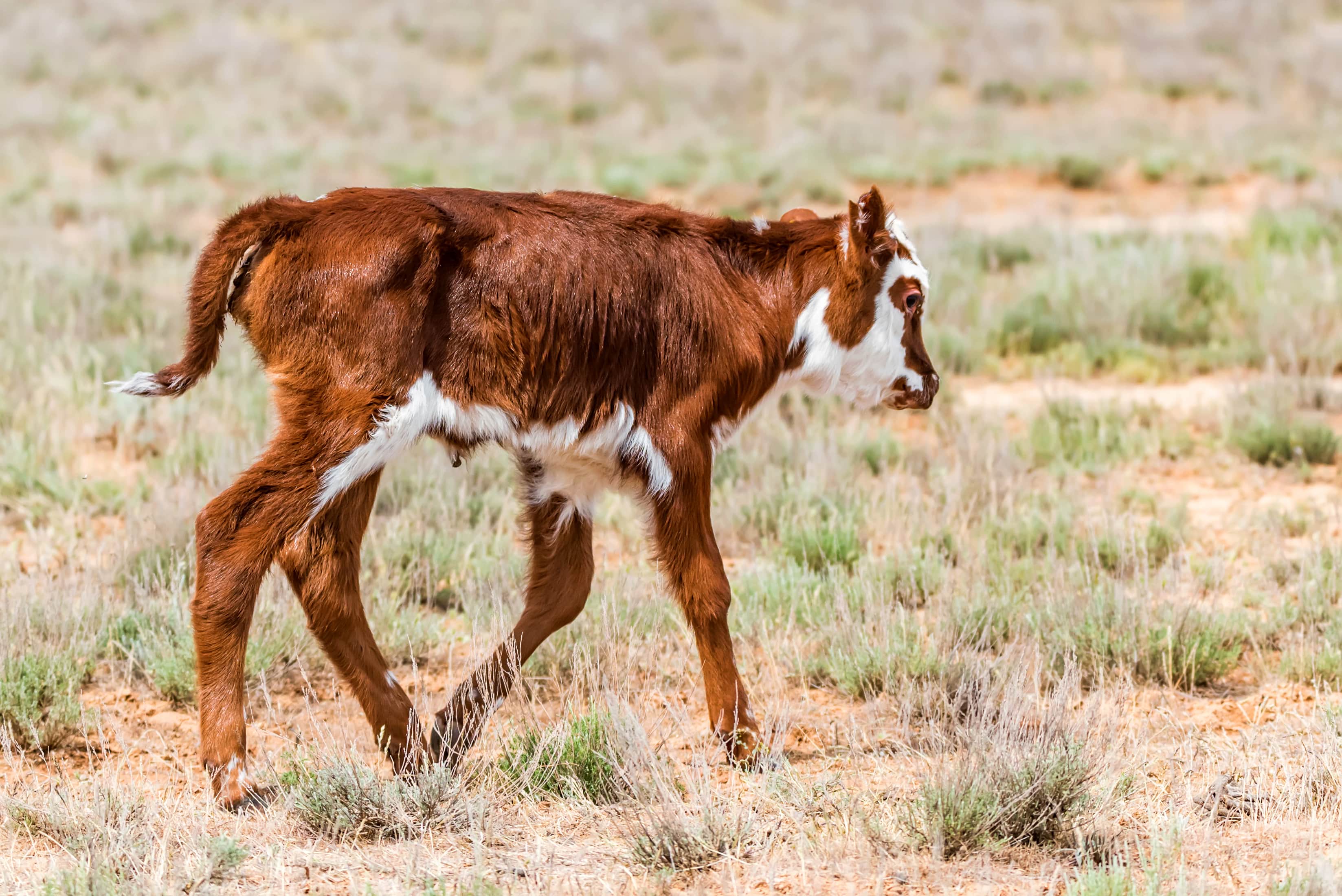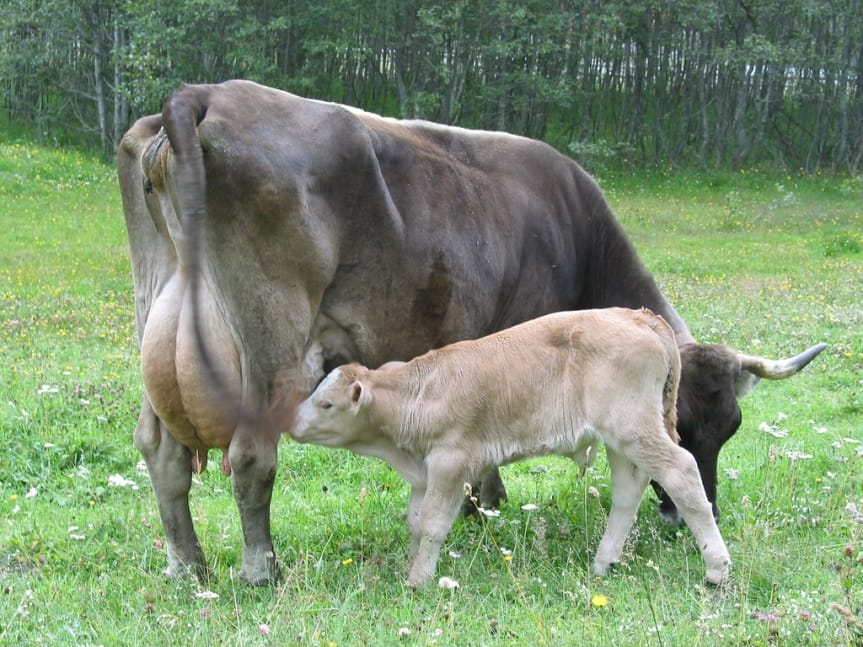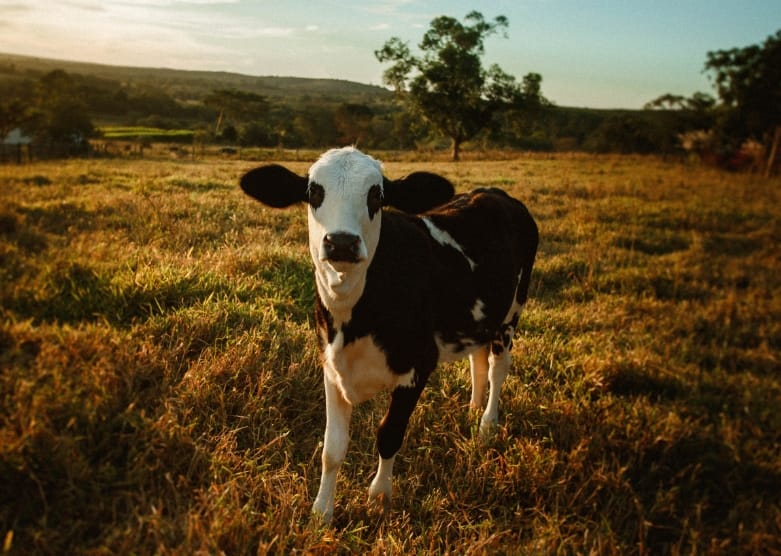Weaning best practices:
As you know, weaning is the process of transitioning your calf from milk intake to a mix of forage or concentrate based diet. It’s when your calves begin to become a complete ruminant.
Weaning can be a stressful event for both, cows and their calves. Studies show that calves during the weaning process lose a bit of weight, no matter what their age is.
So here are a few useful tips to help you prepare your calves are for weaning. Let’s begin with this three-point check:
Rumen:
Rumen development is the most important point in weaning. You need to make sure your calf can consume at least 1 kg of calf meal (starter concentrate and water) or 2 kg of pasture a day. Attempt to wean your calves only after this milestone.
This alone can help you avoid any major weight loss or health disorders.
Bodyweight:
Ensure individuals reach a minimum body weight before weaning. The target weaning weight depends on the rearing system you have. Recommended target weaning weights are 70kg for Jerseys, 80kg for Friesian X Jersey Crossbreds, and 90kg for Friesians. However, each cow is different, so don’t set this as an average for a group.
Age:
Calves are usually weaned between six to eight months of age. You can use the thumb rule of ‘weight and age’ while making your weaning decision, even earlier if needed. For example, you could set a minimum 8 weeks age and a 90 kg weight as your weaning target and if a heifer is at 90 kg at 7 weeks, you will need to wait another week to begin the weaning process.

Overcoming weaning challenges:
Weaning is a challenge for any calf because they are switching from liquid milk to solid pasture, hay and concentrates. They’re also higher chances of bacteria, viruses and fungi entering their system and causing them to fall ill.
Then there are also other factors like changes to their housing, the stress of competing within a new group or herd and vaccinations. So, it’s better to expose your calves to only one stress at a time. This can help you wean your calves successfully.
Establishing a smooth weaning process:
A gradual, step by step process can also help a lot. For example, consider the following steps:
- Target removing milk across a 2-week period. Giving the calf time to take to the solid feed, and slowly increasing the calf starter feed. Monitor calf behavior to spot the fussy or weak ones.
- At the end of two weeks, if your calves are consuming solids even while on milk, do retain the concentrate meal in their diet for 2 weeks after weaning from milk. This to help their rumens to adjust to pasture feeds.
- After the 2 weeks, if pasture quantity and quality alone meets your growth targets, the concentrate meal may also be removed.
- If some of your calves are not functioning well, post the weaning, you may need to add back the calf starter meal, regardless of weight gain or age.
- Regularly weigh your calves. Because calves never lose weight after the weaning process. They either remain static or ideally gain more weight.
What is early weaning? And what are the advantages?
Early weaning is weaning calves at an age younger than 'normal' practice.
In Australia, the normal range of weaning is around 5 months though the range does extend either way by a couple of months in certain environments.
In extreme cases, 'early weaning' (without milk replacer) can be performed safely and effectively down to 4-6 weeks of age, though calves that have reached 3-4 months are considerably easier to feed and manage.
You must feed your early weaners well to help them perform well. You can greatly improve calf performance if early weaners are grouped together by size and age.
Though early weaning would place extra pressure on your calf rearing system, it is a viable option, since it helps cut feed costs and can even be an effective drought management tool.
When you wean your calf early, the following improvements happen:
Cow body condition improves:
Lactating cows lose body condition because of increased nutrient requirements. This can worsen during drought when there is lack of forage. When you wean early, you will eliminate much of the nutrient requirement, saving you money. Your cows’ body condition is maintained as well, prior to the fall or winter feed.
Calf performance improves:
Calves cannot compete with cows for forage, during drought. When you wean early and provide calves with a very nutritious diet, they can reach their weight targets.
Pregnancy rate improves:
Inadequate feed resources adversely impact cow reproductive performance. When you wean early, especially before or during the breeding season, cows get more opportunity to rebreed with optimal time.
Forage availability improves:
When you wean early, cows consume less dry matter, eliminating forage demand from the calf as well. So the cows on pasture get more forage and your pasture demand automatically reduces, improving sustainability and future forage production.
Early weaning is economically advantageous to you, as it reduces labor and housing requirements. It also reduces milk costs and disease management costs.
Types of weaning:
There are four commonly practiced methods of weaning and you have to choose the method(s) most suited to your system. Consider your time availability, farm infrastructure, labor skill levels and market potential while choosing your weaning method.
The important thing is for you to make sure that the weaning process is as stress-free as possible for your calves.

#1 Abrupt weaning:
Quickly remove the calves from the cows and keep them far apart. This can be very stressful. Both cows and calves take longer to settle down after abrupt weaning. It’s not recommended unless its unavoidable.
#2 Gradual weaning:
Place your cows and calves in adjoining paddocks on either side of the fence. Encouraged cows to move away to graze for extended periods, while you group the calves together inside the fence.
Over the next week or so, move cows to paddocks further away. Milk intake is gradually reduced, typically over 10 to 28 days. Calves may lose weight initially, but this is the least stressful method for the calves.
#3 Creep weaning:
This is a gradual "self-weaning" process, less stressful on calves but requires lots of supervision. preparation and supervision.
Give your calves access to quality pasture in an adjacent pasture via a special “creep gate”, a 400 mm wide opening in the fence that will allow only calves to go through, but not the cows.
Slowly your calves will get used to grazing away from cows and then you can close the creep gate and then move the cows away.
#4 Yard weaning:
Yard weaning has two advantages. It minimizes weaning stress and therefore results in healthier animals. And it also introduces calves to human interventions, resulting in quieter animals.
In this method, you separate calves from cows through temporary fences or rubber belts. Ensure calves have at least four square meters per head. Yard weaning demands higher feed and labor costs. But it can offer significant benefits over paddock weaned calves.
An Australian trial in 1997 proved yard weaned calves on average gained an additional 0.15kg of live weight every day, across the first 90 days. The study showed that “Paddock weaned calves averaged 1.28kg/head/day while yard weaned calves grew at 1.45kg/head/day for the first 90 days on feed”.
Valuable weaning tips:
- Rumen development takes time, so does transitioning from calf meal to a pasture diet. It is best to give a two-week gap between each diet change to help transition.
- Chewing cud indicates good rumen development; do make sure 50% of your calves that are not eating well, chew cud.
- Dung pat that can be trailed out with your foot, and has no straw fibre indicates good rumen health, bubbles indicate poor rumen condition.
- Always have water and feed available.
- Ensure high quality calf feed like lucerne hay or silage and clean water troughs, avoiding powdery feed that could irritate eyes making them scratch.
- Raise the feed from the ground and keep water separately, at a short walking distance to prevent spoiling.
- Introduce dry concentrate supplements (e.g. grain) slowly, to increase energy in diet in case your hay/silage is of poor quality.
- Each of your calves has to be individually monitored for concentrate consumption. If calves are fed in a group when accurate measure of starter consumption per calf is difficult, you should monitor the group across three consecutive days.
- In general, calves between three and twelve months of age need high quality forage or feed that has anywhere between 9.5 to 11 MJ of energy per kg of DM.
- Woody calves are those with dry or coarse coats and not suckling adequate milk, and it is better to early wean them on to high quality feed.
- You can wean calves early when the cow health is of concern. Add milk replacers to those calves less than 80 kg.
- Ensure that someone walks the yards/ calf paddocks (without dogs) at least twice daily to help calves socialize.
- Monitor for disease, especially pink eye if yards/ paddocks are dusty. Do not combine stressful procedures of castration, dehorning or vaccination during weaning.
- Calves who are temperamental or fail to settle down despite all your efforts can be marked for culling.

Post weaning diets and growth targets:
The first twelve months are critical for skeletal and muscle growth. So, focus on giving your calves a high protein, nutritious diet to your newly weaned calves, until they reach about 250 kg of live bodyweight.
You will need high quality, fresh pasture or feed concentrates of about 11 MJ of metabolizable energy per kilogram of DM that also has about 16% of crude protein content.
If required, add supplements. Especially if your pasture, hay or silage doesn’t offer enough nutrition. Consult your vet about adding specific micro-nutrients, vitamins and feed additives to their diet.
That brings us to the end of this three-part series on rearing healthy calves. In part one, we spoke about pre-calving care.
In part two, we covered calf nutrition.
And now in part three, we just spoke about effective weaning strategies. We hope you enjoyed this three-part series on calf health. Until we meet again, happy farming.
- The Dedicated Team of Pasture.io, 2020-11-23